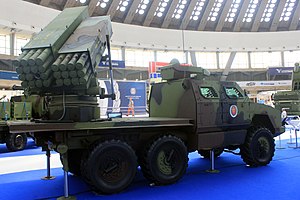M-77 Oganj
| M-77 Oganj | |
|---|---|
 M-77 Oganj of the Serbian Army | |
| Type | Self-propelled multiple rocket launcher |
| Place of origin | Yugoslavia |
| Service history | |
| In service | 1977–present |
| Wars | Yugoslav Wars |
| Production history | |
| Designer | Military Technical Institute |
| Designed | 1968–1975 |
| Manufacturer | BNT (Bosnia and Herzegovina) Krušik (Serbia) 14. oktobar (Serbia) |
| Produced | 1975 |
| Specifications | |
| Mass | 22.4 tonnes (49,383 lbs) |
| Length | 8.4 m (27 ft 7 in) |
| Width | 2.49 m (8 ft 2 in) |
| Height | 3.1 m (10 ft 2 in) |
| Crew | 5 |
| Cartridge | Length: 2.6 m (8 ft 6 in) Weight: 65 kg (143 lb) Warhead: 20 kg (44 lb) |
| Caliber | 128 mm (5.0 in) |
| Barrels | 32 |
| Maximum firing range |
|
Secondary armament | NSV or M2 Browning machine gun |
| Maximum speed | 80 km/h (50 mph) |
The M-77 Oganj (from Serbian: огањ, lit. 'fire') is a 128mm self-propelled multiple rocket launcher developed in the former Yugoslavia. Its NATO designation is YMRL-32.
Development
[edit]Development of the system began in 1968. Professor Obrad Vučurović, mechanical engineer and Chief Operating Officer of the Military Technical Institute's Artillery Department, was responsible for overseeing its development and production.[1]
The six pre-serial production models were based on a FAP 2220 6x6 truck and were shown to the public for the first time in 1975. Serial production commenced two years later. The serial production variant is mounted on FAP 2026 BDS/A 6x6 truck bed. The rocket system is placed on the back of the platform and contains 32 128mm launch tubes capable of reaching targets 20.6 kilometres (12.8 mi) away. The system is operated by five personnel.[2] One of its unique features is its retracting canvas, which allows the rocket launcher to be easily disguised and makes it difficult for the enemy to spot until the crew is ready to fire. It is thus an effective means of military deception.[citation needed] In 1994, Serbia developed a new version called the M-94 Oganj C, which could fire the rockets M91 (cluster-type warhead with 40 submunition grenades) and M77 (HE warhead). This version featured a 32-rocket reloading system which makes it possible to fully reload and launch a second salvo within three minutes.[citation needed]
Modernization
[edit]The Military Technical Institute has prepared a modernization package for the system on request from the Serbian Armed Forces which includes a modern navigation and fire control system. The rocket launcher was also modified to be able to fire several different types of rockets, including the 122mm BM-21 Grad. As part of the modernization program, a new 128mm rocket with a range of 50 kilometres (31 mi) and improved circular error probable (CEP) will be produced by Krušik. For the needs of the Serbian Army, the modernization process entailed a switch to modern digitalized technology, which enables the crew to occupy a firing position, fire their rockets and leave three minutes without exiting the vehicle, whereas it previously took 26 minutes to assume a position and fire a salvo. At that time, it included occupying the orientation position and determining the coordinates of the firing position, directing the weapon in the azimuth of the basic direction, calculating the initial elements, correction and group shooting. Due to the new automatic aiming line, automatic determination of the coordinates of the firing position and shooting elements, as well as the new inertial navigation system and GPRS navigation, the modernized variant is able to open fire much faster, more precisely and with a greater effect on the target. New M-18 missiles with a range of up to 40 kilometres (25 mi) have also been introduced, as has a new rocket with path correction and with a range of up to 50 kilometres (31 mi). The latter has entered serial production for delivery to the Serbian Army.
Further development of the M-77 concept and the LRSVM Morava led to the creation of the new modular rocket launcher M-18 Oganj, which contains an armored cabin on a 6x6 chassis for up-close battlefield action. It is also capable of launching the Košava 1 and ALAS missiles, among others.[3][4]
-
Modernized M-77 Oganj
-
Modernized M-77 Oganj
-
Modernized M-77 Oganj
Operators
[edit]
Current operators
[edit] Bosnia and Herzegovina – 20[5]
Bosnia and Herzegovina – 20[5] Croatia – 12 (uses 122mm rockets)
Croatia – 12 (uses 122mm rockets) Serbia – 60[6]
Serbia – 60[6]
Former operators
[edit] Yugoslavia – Passed on to successor states
Yugoslavia – Passed on to successor states
See also
[edit]Related development
[edit]- M-63 Plamen – (Socialist Federal Republic of Yugoslavia)
- M-87 Orkan – (Yugoslavia)
- M-18 Oganj – (Serbia)
Comparable systems
[edit]- BM-21 Grad – (Soviet Union)
- LAROM – (Romania)
- RM-70 – (Czechoslovakia)
- WR-40 Langusta – (Poland)
Compatible with
[edit]- LRSVM Morava – (Serbia) - newly developed MLRS for Serbian Army as well as exports; planned replacement of M-77 Oganj and M-63 Plamen
References
[edit]- ^ Obrad Vucurović Archived March 2, 2009, at the Wayback Machine
- ^ "M-77 Oganj". man.fas.org.
- ^ "Vulin: Vojska Srbije ne prestaje sa modernizacijom i opremanjem".
- ^ "Ministar Vulin: Unapređujemo borbenu gotovost".
- ^ Administrator. "Bosnia Herzegovina army land ground armed defense forces military equipment armored vehicle UK | Bosnia Herzegovina army land ground forces UK | East Europe UK". www.armyrecognition.com. Retrieved 2018-04-01.
- ^ Military Balance 2016. International Institute for Strategic Studies. Arundel House, Temple Place, London, UK. 9 February 2016. ISBN 978-1-85743-835-2. OCLC 920018706.
{{cite book}}: CS1 maint: location missing publisher (link) CS1 maint: others (link)



